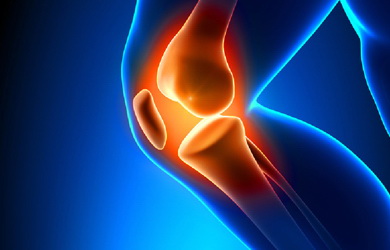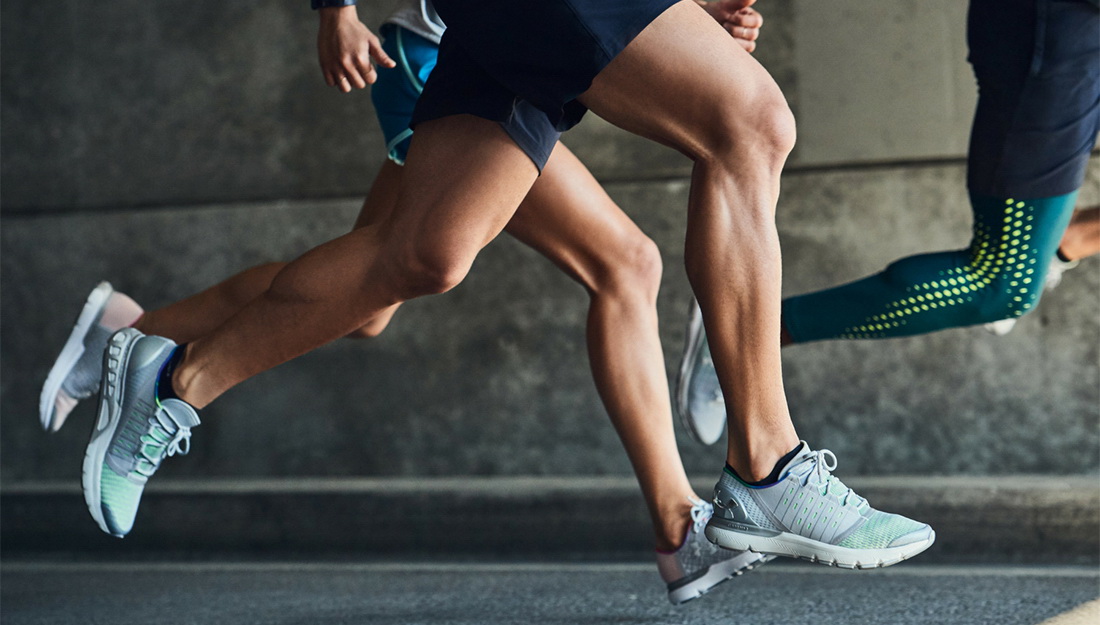
Ask A Pro, Get Answers | Running Knee Pain
Ask A Pro, Get Answers
Running Knee Pain

Q:
I’m training for my first marathon this year and have started to experience some knee problems with my increased training volume. The pain is on the inside of my right knee, which becomes very tender and swollen after running. The therapists I have seen told me it was Patellofemoral Pain Syndrome and gave me mini-squat exercises and some stretches to strengthen the inside of my thigh, but they only seem to make it worse.
A:
Knee pain is a common and debilitating condition for recreational and elite runners. Patellofemoral Pain Syndrome (PFPS) is an umbrella term referring to general knee pain and dysfunction around the knee cap. Chronic inflammatory conditions like this can be present unilaterally (on one side of the body) or bilaterally (on both sides of the body). Since many of the muscles and tendons attaching to the knee originate from the hip and pelvis, it is important to assess the pelvis when evaluating these injuries. Pelvic misalignment and associated muscle imbalances can cause changes in mechanics at the knee, resulting in increased wear and tear of the knee, such as behind the patella or at the knee tendon attachments (pes anserine attachment). There is also logical reason as to why the mini squat exercises are exacerbating your knee pain. The exercise is meant to strengthen the Vastus Medialis muscle which in theory is suppose to "fix" how the knee cap tracks which should reduce the friction that the knee cap is experiencing. New studies have shown that the vastus medialis is not fascially attached to the knee cap and actually does not change how it tracks. The exercise may in turn create more pressure onto the knee cap and the surrounding bursa. At Evolution Sport Therapy, we tackle this issue via multiple fronts. Neutral pelvic alignment must be achieved , then active release technique and myofascial release where the Quad (front Thigh muscle) attaches onto the knee cap to relieve the pressure on the knee cap. Then strengthening the glut med and hamstring muscles to help stabilize the pelvis and knee to make sure your body can withstand the rigours of running.
Jonathan Sun BPE, CAT(C)
Certified Athletic Therapist
Ask A Pro, Get Answers
Running Knee Pain

Q:
I’m training for my first marathon this year and have started to experience some knee problems with my increased training volume. The pain is on the inside of my right knee, which becomes very tender and swollen after running. The therapists I have seen told me it was Patellofemoral Pain Syndrome and gave me mini-squat exercises and some stretches to strengthen the inside of my thigh, but they only seem to make it worse.
A:
Knee pain is a common and debilitating condition for recreational and elite runners. Patellofemoral Pain Syndrome (PFPS) is an umbrella term referring to general knee pain and dysfunction around the knee cap. Chronic inflammatory conditions like this can be present unilaterally (on one side of the body) or bilaterally (on both sides of the body). Since many of the muscles and tendons attaching to the knee originate from the hip and pelvis, it is important to assess the pelvis when evaluating these injuries. Pelvic misalignment and associated muscle imbalances can cause changes in mechanics at the knee, resulting in increased wear and tear of the knee, such as behind the patella or at the knee tendon attachments (pes anserine attachment). There is also logical reason as to why the mini squat exercises are exacerbating your knee pain. The exercise is meant to strengthen the Vastus Medialis muscle which in theory is suppose to "fix" how the knee cap tracks which should reduce the friction that the knee cap is experiencing. New studies have shown that the vastus medialis is not fascially attached to the knee cap and actually does not change how it tracks. The exercise may in turn create more pressure onto the knee cap and the surrounding bursa. At Evolution Sport Therapy, we tackle this issue via multiple fronts. Neutral pelvic alignment must be achieved , then active release technique and myofascial release where the Quad (front Thigh muscle) attaches onto the knee cap to relieve the pressure on the knee cap. Then strengthening the glut med and hamstring muscles to help stabilize the pelvis and knee to make sure your body can withstand the rigours of running.
Jonathan Sun BPE, CAT(C)
Certified Athletic Therapist
Ask A Pro, Get Answers
Running Knee Pain

Q:
I’m training for my first marathon this year and have started to experience some knee problems with my increased training volume. The pain is on the inside of my right knee, which becomes very tender and swollen after running. The therapists I have seen told me it was Patellofemoral Pain Syndrome and gave me mini-squat exercises and some stretches to strengthen the inside of my thigh, but they only seem to make it worse.
A:
Knee pain is a common and debilitating condition for recreational and elite runners. Patellofemoral Pain Syndrome (PFPS) is an umbrella term referring to general knee pain and dysfunction around the knee cap. Chronic inflammatory conditions like this can be present unilaterally (on one side of the body) or bilaterally (on both sides of the body). Since many of the muscles and tendons attaching to the knee originate from the hip and pelvis, it is important to assess the pelvis when evaluating these injuries. Pelvic misalignment and associated muscle imbalances can cause changes in mechanics at the knee, resulting in increased wear and tear of the knee, such as behind the patella or at the knee tendon attachments (pes anserine attachment). There is also logical reason as to why the mini squat exercises are exacerbating your knee pain. The exercise is meant to strengthen the Vastus Medialis muscle which in theory is suppose to "fix" how the knee cap tracks which should reduce the friction that the knee cap is experiencing. New studies have shown that the vastus medialis is not fascially attached to the knee cap and actually does not change how it tracks. The exercise may in turn create more pressure onto the knee cap and the surrounding bursa. At Evolution Sport Therapy, we tackle this issue via multiple fronts. Neutral pelvic alignment must be achieved , then active release technique and myofascial release where the Quad (front Thigh muscle) attaches onto the knee cap to relieve the pressure on the knee cap. Then strengthening the glut med and hamstring muscles to help stabilize the pelvis and knee to make sure your body can withstand the rigours of running.
Jonathan Sun BPE, CAT(C)
Certified Athletic Therapist
Ask A Pro, Get Answers
Running Knee Pain

Q:
I’m training for my first marathon this year and have started to experience some knee problems with my increased training volume. The pain is on the inside of my right knee, which becomes very tender and swollen after running. The therapists I have seen told me it was Patellofemoral Pain Syndrome and gave me mini-squat exercises and some stretches to strengthen the inside of my thigh, but they only seem to make it worse.
A:
Knee pain is a common and debilitating condition for recreational and elite runners. Patellofemoral Pain Syndrome (PFPS) is an umbrella term referring to general knee pain and dysfunction around the knee cap. Chronic inflammatory conditions like this can be present unilaterally (on one side of the body) or bilaterally (on both sides of the body). Since many of the muscles and tendons attaching to the knee originate from the hip and pelvis, it is important to assess the pelvis when evaluating these injuries. Pelvic misalignment and associated muscle imbalances can cause changes in mechanics at the knee, resulting in increased wear and tear of the knee, such as behind the patella or at the knee tendon attachments (pes anserine attachment). There is also logical reason as to why the mini squat exercises are exacerbating your knee pain. The exercise is meant to strengthen the Vastus Medialis muscle which in theory is suppose to "fix" how the knee cap tracks which should reduce the friction that the knee cap is experiencing. New studies have shown that the vastus medialis is not fascially attached to the knee cap and actually does not change how it tracks. The exercise may in turn create more pressure onto the knee cap and the surrounding bursa. At Evolution Sport Therapy, we tackle this issue via multiple fronts. Neutral pelvic alignment must be achieved , then active release technique and myofascial release where the Quad (front Thigh muscle) attaches onto the knee cap to relieve the pressure on the knee cap. Then strengthening the glut med and hamstring muscles to help stabilize the pelvis and knee to make sure your body can withstand the rigours of running.
Jonathan Sun BPE, CAT(C)
Certified Athletic Therapist
© Copyright Evolution Sport Therapy 2022.
Newsletter Signup
Sign up for our newsletter to receive all the latest!
Newsletter Signup
Sign up for our newsletter to receive all the latest!
© Copyright Evolution Sport Therapy 2022.
Newsletter Signup
Sign up for our newsletter to receive all the latest!
© Copyright Evolution Sport Therapy 2022.